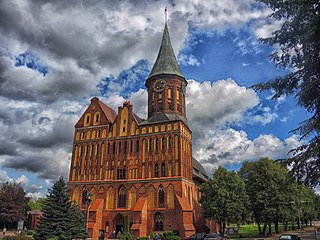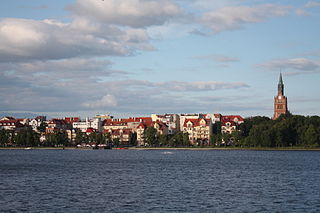
Masuria is an ethnographic and geographic region in northern and northeastern Poland, known for its 2,000 lakes. Masuria occupies much of the Masurian Lake District. Administratively, it is part of the Warmian-Masurian Voivodeship. Its biggest city, often regarded as its capital, is Ełk. The region covers a territory of some 10,000 km2 which is inhabited by approximately 500,000 people.

East Prussia was a province of the Kingdom of Prussia from 1772 to 1829 and again from 1878 ; following World War I it formed part of the Weimar Republic's Free State of Prussia, until 1945. Its capital city was Königsberg. East Prussia was the main part of the region of Prussia along the southeastern Baltic Coast.

The Masurians or Mazurs, historically also known as Prussian Masurians, are an ethnic group originating from the region of Masuria, within the Warmian-Masurian Voivodeship, Poland. They number around 5,000–15,000 people. In the 2011 Polish census, 1,376 individuals declared themselves to be Masurian as either a first or a secondary identification. Before World War II and its post-war expulsions, Masurians used to be a more numerous ethnic group found in the southern parts of East Prussia for centuries following the 16th century Protestant Reformation. Today, most Masurians live in what is now Germany and elsewhere.

Prussia is a historical region in Central Europe on the south-eastern coast of the Baltic Sea, that ranges from the Vistula delta in the west to the end of the Curonian Spit in the east and extends inland as far as Masuria, divided between Poland, Russia and Lithuania. This region is often also referred to as Old Prussia.

Mrągowo is a resort town in the Warmian-Masurian Voivodeship of northeastern Poland, with 21,889 inhabitants (2019). It is the capital of Mrągowo County and the seat the Gmina Mrągowo. The town is located in the historical region of Masuria, within the Masurian Lake District, about 60 km (37 mi) east of Olsztyn.

Szczytno is a town in northeastern Poland with 27,970 inhabitants (2004). It is the seat of Szczytno County in the Warmian-Masurian Voivodship, within the historic region of Masuria.

Kętrzyn is a town in northeastern Poland with 27,478 inhabitants (2019). It is the capital of Kętrzyn County in the Warmian–Masurian Voivodeship.

Ełk, also seen absent Polish diacritics as Elk, is a city in northeastern Poland with 61,677 inhabitants as of December 2021. It is the seat of Ełk County in Warmian-Masurian Voivodeship. It lies on the shore of Ełk Lake, which was formed by a glacier, and is surrounded by extensive forests. It is the largest city and unofficial capital of historical Masuria. One of the principal attractions in the area is legal hunting.

Giżycko is a town in northeastern Poland with 28,597 inhabitants as of December 2021. It is situated between Lake Kisajno and Lake Niegocin in the region of Masuria, within the Warmian-Masurian Voivodeship. It is the seat of Giżycko County.

Stębark is a village in the administrative district of Gmina Grunwald, within Ostróda County, Warmian-Masurian Voivodeship, in northern Poland. The village is chiefly known for two historic battles which took place there or nearby: the 1410 Battle of Grunwald and the (Second) Battle of Tannenberg in World War I.

Pisz is a historic town in the Warmian-Masurian Voivodeship in northern Poland, with a population of 19,466 (2016). It is the seat of Pisz County. Pisz is situated at the junction of Lake Roś and the Pisa River, in the region of Masuria.

Ossoliński National Institute, or the Ossolineum is a Polish cultural foundation, publishing house, archival institute and a research centre of national significance founded in 1817 in Lwów. Located in the city of Wrocław since 1947, it is the second largest institution of its kind in Poland after the ancient Jagiellonian Library in Kraków. Its publishing arm is the oldest continuous imprint in Polish since the early 19th century. It bears the name of its founder, Polish nobleman, Count Józef Maksymilian Ossoliński (1748-1826).

Węgorzewo is a tourist town on the Angrapa River in northeastern Poland, within the historical region of Masuria. It is the seat of Węgorzewo County in the Warmian-Masurian Voivodeship and is located not far from the border with Russia's Kaliningrad Oblast. Lake Mamry is close to the town.

Wielbark is a town in Szczytno County, Warmian-Masurian Voivodeship, in northern Poland. It is the seat of the gmina called Gmina Wielbark. It lies approximately 19 kilometres (12 mi) south of Szczytno and 52 km (32 mi) south-east of the regional capital Olsztyn. It is part of historic Masuria.

Ryn is a town in northeastern Poland located 19 km (12 mi) southwest of Giżycko, in the Warmian-Masurian Voivodeship, in Masuria. Until the reorganization of 1999 it had been assigned to Suwałki Voivodeship. It had a population of 3,062 inhabitants as of December 31, 2004.

Biała Piska is a town in Pisz County, Warmian-Masurian Voivodeship, Poland, with 3,986 inhabitants as of December 2021.
Krokowo is a village in the administrative district of Gmina Kozłowo, within Nidzica County, Warmian-Masurian Voivodeship, in northern Poland. It is located in Masuria. It lies approximately 9 kilometres (6 mi) south-east of Kozłowo, 13 km (8 mi) south of Nidzica, and 60 km (37 mi) south of the regional capital Olsztyn.

Cimochy is a village in the administrative district of Gmina Wieliczki, within Olecko County, Warmian-Masurian Voivodeship, in north-eastern Poland. It is located in the historic region of Masuria.

The "P" symbol or "P" badge was introduced on 8 March 1940 by the Nazi Germany General Government in relation to the requirement that Polish workers (Zivilarbeiter) used during World War II as forced laborers in Germany display a visible symbol marking their ethnic origin. The symbol was introduced with the intent to be used as a cloth patch, which indeed was the most common form, but also reproduced on documents and posters. The badge was intended to be humiliating, and like the similar Jewish symbol, can be seen as a badge of shame.




















